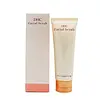DHC Facial Scrub Versus DHC Concentrated Eye Cream
What's inside
What's inside
 Key Ingredients
Key Ingredients

 Benefits
Benefits

 Concerns
Concerns

 Ingredients Side-by-side
Ingredients Side-by-side

Water
Skin ConditioningStearic Acid
CleansingButylene Glycol
HumectantPrunus Armeniaca Seed Powder
AbrasivePentylene Glycol
Skin ConditioningPotassium Cocoate
EmulsifyingPotassium Hydroxide
BufferingGlyceryl Stearate
EmollientPEG-100 Stearate
Urea
BufferingAllantoin
Skin ConditioningSapindus Mukorossi Peel Extract
Skin ConditioningChlorhexidine Digluconate
AntimicrobialDipotassium Glycyrrhizate
HumectantPhenoxyethanol
PreservativeWater
Skin ConditioningButylene Glycol
HumectantCaprylic/Capric Triglyceride
MaskingOlea Europaea Fruit Oil
MaskingStearic Acid
CleansingHydrogenated Palm Oil
EmollientSqualane
EmollientGlycerin
HumectantPentylene Glycol
Skin ConditioningPolysorbate 60
EmulsifyingLeuconostoc/Radish Root Ferment Filtrate
AntimicrobialCetyl Alcohol
EmollientSorbitan Stearate
EmulsifyingAlcohol
AntimicrobialPhenoxyethanol
PreservativePotassium Hydroxide
BufferingRosmarinus Officinalis Leaf Extract
AntimicrobialCarbomer
Emulsion StabilisingMagnesium Aluminum Silicate
AbsorbentDipotassium Glycyrrhizate
HumectantTocopherol
AntioxidantBiosaccharide Gum-1
HumectantAesculus Hippocastanum Seed Extract
Skin ConditioningSodium Hyaluronate
HumectantSasa Veitchii Leaf Extract
Skin ConditioningPanax Ginseng Root Extract
EmollientCucumis Sativus Fruit Extract
EmollientRoyal Jelly Extract
Skin ConditioningCitric Acid
BufferingWater, Butylene Glycol, Caprylic/Capric Triglyceride, Olea Europaea Fruit Oil, Stearic Acid, Hydrogenated Palm Oil, Squalane, Glycerin, Pentylene Glycol, Polysorbate 60, Leuconostoc/Radish Root Ferment Filtrate, Cetyl Alcohol, Sorbitan Stearate, Alcohol, Phenoxyethanol, Potassium Hydroxide, Rosmarinus Officinalis Leaf Extract, Carbomer, Magnesium Aluminum Silicate, Dipotassium Glycyrrhizate, Tocopherol, Biosaccharide Gum-1, Aesculus Hippocastanum Seed Extract, Sodium Hyaluronate, Sasa Veitchii Leaf Extract, Panax Ginseng Root Extract, Cucumis Sativus Fruit Extract, Royal Jelly Extract, Citric Acid
 Reviews
Reviews

Ingredients Explained
These ingredients are found in both products.
Ingredients higher up in an ingredient list are typically present in a larger amount.
Butylene Glycol (or BG) is used within cosmetic products for a few different reasons:
Overall, Butylene Glycol is a safe and well-rounded ingredient that works well with other ingredients.
Though this ingredient works well with most skin types, some people with sensitive skin may experience a reaction such as allergic rashes, closed comedones, or itchiness.
Learn more about Butylene GlycolDipotassium Glycyrrhizate comes from licorice root.
Extracts of licorice have demonstrated to have antibacterial, anti‐inflammatory, antiviral, antioxidant properties.
One component, glabridin, has extra potent antioxidant and soothing properties. It has also been found to block pigmentation from UVB rays in guinea pigs.
Licorice Root also contains a flavonoid. Flavonoids are a natural substance from in plants. Flavonoids also have antioxidant properties.
Another component, glycyrrhizin, has been found to have anti-inflammatory and antimicrobial benefits. This may make licorice root extract effective at treating acne. However, more research is needed to support this.
Liquiritin is one of the flavone compounds found in licorice. It has been found to help lighten skin by preventing tyrosinase from reacting with tyrosine. When the two react, protein is converted to melanin. Melanin is the substance in your body that gives your features pigmentation.
Licorice root is native to Southern Europe and Asia. It has been used in traditional Chinese medicine to help with respiratory issues.
Learn more about Dipotassium GlycyrrhizatePentylene glycol is typically used within a product to thicken it. It also adds a smooth, soft, and moisturizing feel to the product. It is naturally found in plants such as sugar beets.
The hydrophilic trait of Pentylene Glycol makes it a humectant. As a humectant, Pentylene Glycol helps draw moisture from the air to your skin. This can help keep your skin hydrated.
This property also makes Pentylene Glycol a great texture enhancer. It can also help thicken or stabilize a product.
Pentylene Glycol also acts as a mild preservative and helps to keep a product microbe-free.
Some people may experience mild eye and skin irritation from Pentylene Glycol. We always recommend speaking with a professional about using this ingredient in your routine.
Pentylene Glycol has a low molecular weight and is part of the 1,2-glycol family.
Learn more about Pentylene GlycolPhenoxyethanol is a preservative that has germicide, antimicrobial, and aromatic properties. Studies show that phenoxyethanol can prevent microbial growth. By itself, it has a scent that is similar to that of a rose.
It's often used in formulations along with Caprylyl Glycol to preserve the shelf life of products.
Potassium hydroxide is commonly known as caustic potash. It is used to fix the pH of a product or as a cleaning agent in soap. In cleansers, it is used for the saponification of oils.
Sapnification is the process of creating fatty acid metal salts from triglycerides and a strong base. During this process, Potassium Hydroxide is used up and is not present in the final product.
Using high concentrations of Potassium Hydroxide have shown to irritate the skin.
Learn more about Potassium HydroxideStearic Acid is a fatty acid. It is an emollient, emulsifier, and texture enhancer.
As an emollient, stearic acid helps soften skin. It aids the skin's protective barrier by preventing water loss. It also provides a gentle cleansing effect without stripping away natural oils.
Stearic acid may also be used to enhance the texture of products. It can add volume and stabilize ingredients such as water and oil. This can help water and oil ingredients from separating.
Sources of stearic acid include animal or vegetable fats/oils such as coconut or shea. It can be naturally found in butter, cocoa butter, shea butter, vegetable fats, and animal tallow.
This ingredient may not be Malassezia folliculitis, or fungal-acne safe.
Learn more about Stearic AcidWater. It's the most common cosmetic ingredient of all. You'll usually see it at the top of ingredient lists, meaning that it makes up the largest part of the product.
So why is it so popular? Water most often acts as a solvent - this means that it helps dissolve other ingredients into the formulation.
You'll also recognize water as that liquid we all need to stay alive. If you see this, drink a glass of water. Stay hydrated!
Learn more about Water